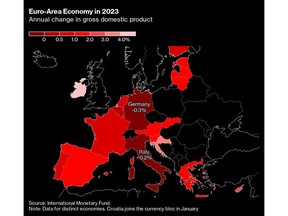European Central Bank Governing Council member Martins Kazaks said interest rates should be raised beyond year-end — a time when economists increasingly expect the euro zone to be in the midst of a recession.

Article content
(Bloomberg) — Sign up for the New Economy Daily newsletter, follow us @economics and subscribe to our podcast.
Advertisement 2
Article content
European Central Bank Governing Council member Martins Kazaks said interest rates should be raised beyond year-end — a time when economists increasingly expect the euro zone to be in the midst of a recession.
Article content
The reason for the prolonged hawkish stance, according to the Latvian official, is that elevated inflation is likely to persist despite a downturn. He backs a hike of 75 basis points this month and another 50 or 75 at the final meeting of 2022 in December, depending on data and the outlook for prices.
“Given the current trend, I don’t see any need to pause after that,” Kazaks said in an interview in Washington. “The pace could slow down somewhat, and I would say that we start to use a wider set of instruments to work across the whole yield curve.”
Advertisement 3
Article content
As borrowing costs are increased after a decade-long hiatus, some officials advocate reassessing the situation when the neutral rate that neither stimulates nor holds back the economy is reached. But with that point — thought to be 1.5%-2% — expected to come before the year is out, hawks like Kazaks are already starting to call for tightening into restrictive territory.
Belgian central bank Governor Pierre Wunsch said last week that a deposit rate of 3% — up from 0.75% now — isn’t unreasonable, given the outlook for consumer-price growth that’s already five times the 2% target. His Dutch colleague, Klaas Knot, sees hikes persisting beyond neutral, albeit more slowly.
At that time, monetary tightening will include commercial banks repaying crisis-era loans known as TLTROs, while the ECB should also start to reduce the approximately €5 trillion ($4.9 trillion) in assets it purchased in past stimulus drives, according to Kazaks.
Advertisement 4
Article content
Kicking off so-called quantitative tightening in 2023 is popular among other hawks.
“If you only work with rates, then you may flatten the yield curve — you want to work with the longer end,” Kazaks said. “I simply don’t see the need to hold onto that bigger balance sheet. Plus, if we are tightening our monetary policy, it’s also necessary that all instruments point into the same direction.”
An important lesson from the pandemic is that monetary policy was more effective when it “combined and mixed different instruments,” according to Kazaks. While interest rates are the ECB’s “preferred” instrument, “we should consider using the same strategy when we are going toward tightening,” also taking into account financial-stability risks, he said.
Advertisement 5
Article content
With the International Monetary Fund predicting a euro-zone recession in the second half of 2022 as the energy crisis bites, Kazaks acknowledges the danger of a downturn.
“It’s much easier to find negative than positive shocks,” he said. “Risks are clearly on the downside for growth and on the upside for inflation.”
He’d be “positively surprised” if new ECB projections due in December don’t include a recession. The only question is how deep and how long it will be — and that will shape the path for monetary policy.
“I don’t think we should be worried too much at the current moment about raising rates,” Kazaks said. “But the higher we climb, the more cautious in terms of the size of the steps we should become.”
